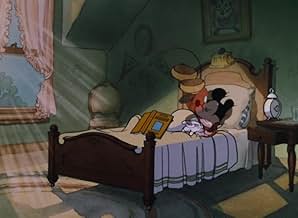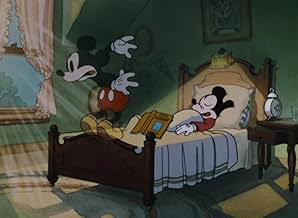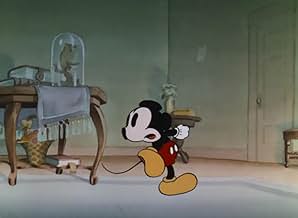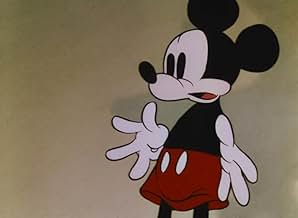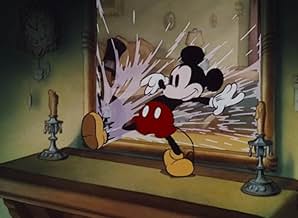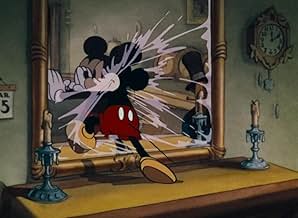VALUTAZIONE IMDb
7,5/10
2987
LA TUA VALUTAZIONE
Topolino sta leggendo un libro ma si addormenta. Al suo risveglio, riesce ad attraversare lo specchio "magico" di casa sua, andando dall'altra parte.Topolino sta leggendo un libro ma si addormenta. Al suo risveglio, riesce ad attraversare lo specchio "magico" di casa sua, andando dall'altra parte.Topolino sta leggendo un libro ma si addormenta. Al suo risveglio, riesce ad attraversare lo specchio "magico" di casa sua, andando dall'altra parte.
- Regia
- Sceneggiatura
- Star
Pinto Colvig
- Radio Hiccup
- (voce)
Walt Disney
- Mickey Mouse
- (voce)
- (non citato nei titoli originali)
Recensioni in evidenza
"Thru the Mirror" is a fun literary take on the Lewis Caroll classic "Through the Looking Class". While not especially faithful, it is tremendously entertaining for a number of reasons. Whether it is the lovely Technicolour animation, with the colourful backgrounds and interesting character features. Whether it is the wonderful music, it is rousing on the most part, with a little snippet of Schubert's "Marche Millitaire". Whether it is the great scene with the cards chasing Mickey. Whether it is Mickey in the role of Alice, and doing it with gusto I must say. I will say though I do think Mickey has done better cartoons namely "Sorceror's Apprentice", "The Band Concert" and "Symphony Hour". But this is great fun as a cartoon, and works on multiple viewings. 10/10 Bethany Cox
Fun Disney take on Lewis Carroll's "Through the Looking Glass." Here Mickey Mouse falls asleep reading that book, then his spirit leaves his body and goes through a mirror. On the other side of the mirror is a wacky version of Mickey's house where the inanimate objects have come to life. A lot of really cool trippy stuff follows that I don't want to spoil for you. Needless to say it's awesome to watch, especially for the time in which it was made. The animation is top-notch (it was Disney, after all). The characters and backgrounds are all well-drawn and the action is excitingly realized. Love the music, too. Fine voice work from Walt Disney. This is as wacky and creative as it gets for 1936 and I can't imagine anyone not having a good time with it. Just a fun cartoon from start to finish.
After falling asleep reading Alice Through the Looking Glass, Mickey dreams about walking through the mirror and entering and opposite world where almost everything is alive and has a personality. Sort of in the same way as all those annoying, singing teacups in the awful Beauty and the Beast movie.
There are many references to Alice in Wonderland of course, some subtle, some obvious and some intelligent. Though it's all great fun and wildly imaginative. It's these sort of cartoons that made Disney Studios and Mickey Mouse legendary.
In a way, it's the success of cartoon like this that are to blame for the existence of stuff like The Haunted Mansion.
But that's just the pessimist in me.
There are many references to Alice in Wonderland of course, some subtle, some obvious and some intelligent. Though it's all great fun and wildly imaginative. It's these sort of cartoons that made Disney Studios and Mickey Mouse legendary.
In a way, it's the success of cartoon like this that are to blame for the existence of stuff like The Haunted Mansion.
But that's just the pessimist in me.
No borrowed source was more important to the success of Disney than Lewis Carroll's Alice books--from the silent Alice comedies to the beginning of its modern-day live-action remakes with Tim Burton's CGI trash--and here the parody of an adaptation is coupled with the studio's most iconic original creation, Mickey Mouse. The result arguably is more in the spirit, at least on a per-minute basis within the short cartoon, of Carroll's nonsense fairy tales than Disney's later, feature-length "Alice in Wonderland" (1951). Although it's in such a hurry to cram as many references to the books, spoofs of popular movies and other silliness into its nine minutes that it can't even be bothered to spell out the word "through," at least, of more importance, Disney spelled Carroll's name correctly this time.
The title and the book-within-the-book explicitly cite Carroll's sequel "Through the Looking Glass," but all of the deck of cards business is from the original "Alice's Adventures in Wonderland." Specific references to the Alice books include the narrative being framed as a dream, Mickey going through the mirror, his growing bigger and smaller from eating, anthropomorphic creatures (although often quite different ones here than in the books), clock and spiral motifs and the cards, as well as Mickey's and the proceeding's generally playful demeanor. There are even a couple puns made of Mickey's exclamations of "nuts" and "skip it," as well as the "calling all cards." There's some tap dancing, including on a top hat, as Fred Astaire and Ginger Rogers had recently starred in "Top Hat" (1935), I guess, to compliment the parodying of Busby Berkeley musicals, swashbucklers and war films. The Queen of Hearts somewhat looks like Greta Garbo, perhaps from "Queen Christina" (1933), while the King bears a passing resemblance to Charles Laughton from "The Private Life of Henry VIII" (1933). The Technicolor looks good, too, and there's a nice sound bridge made of the anthropomorphic phone ringing within the mirror dream and the alarm clock going off on the other side. It's a clever and well-constructed cartoon.
The title and the book-within-the-book explicitly cite Carroll's sequel "Through the Looking Glass," but all of the deck of cards business is from the original "Alice's Adventures in Wonderland." Specific references to the Alice books include the narrative being framed as a dream, Mickey going through the mirror, his growing bigger and smaller from eating, anthropomorphic creatures (although often quite different ones here than in the books), clock and spiral motifs and the cards, as well as Mickey's and the proceeding's generally playful demeanor. There are even a couple puns made of Mickey's exclamations of "nuts" and "skip it," as well as the "calling all cards." There's some tap dancing, including on a top hat, as Fred Astaire and Ginger Rogers had recently starred in "Top Hat" (1935), I guess, to compliment the parodying of Busby Berkeley musicals, swashbucklers and war films. The Queen of Hearts somewhat looks like Greta Garbo, perhaps from "Queen Christina" (1933), while the King bears a passing resemblance to Charles Laughton from "The Private Life of Henry VIII" (1933). The Technicolor looks good, too, and there's a nice sound bridge made of the anthropomorphic phone ringing within the mirror dream and the alarm clock going off on the other side. It's a clever and well-constructed cartoon.
Fantastic, I remember me being younger and seeing this short, even very good. I highly recommend it.
Lo sapevi?
- QuizThis short is featured as a playable level in the video game Epic Mickey: La Leggendaria Sfida di Topolino (2010).
- BlooperThere is a series of scratches visible throughout, apparently from the platten glass used to hold the artwork under the camera.
- Citazioni
King of Hearts: [top half] Call out the cards!
King of Hearts: [bottom half] Call out the cards!
King of Hearts: [both halves] Call out the cards! Call out the cards!
Radio: [repeatedly] Calling all cards. Calling all cards.
- ConnessioniEdited into Topolino Story (1968)
I più visti
Accedi per valutare e creare un elenco di titoli salvati per ottenere consigli personalizzati
Dettagli
- Data di uscita
- Paese di origine
- Lingua
- Celebre anche come
- Attraverso lo specchio
- Azienda produttrice
- Vedi altri crediti dell’azienda su IMDbPro
- Tempo di esecuzione9 minuti
- Proporzioni
- 1.37 : 1
Contribuisci a questa pagina
Suggerisci una modifica o aggiungi i contenuti mancanti

